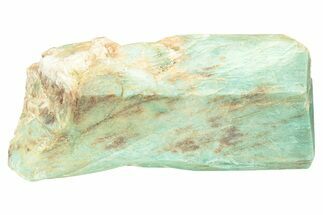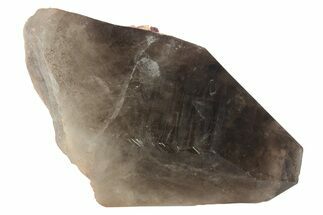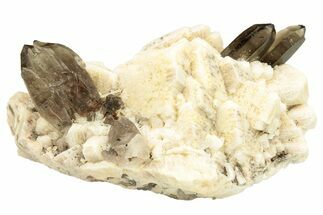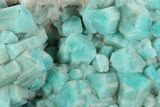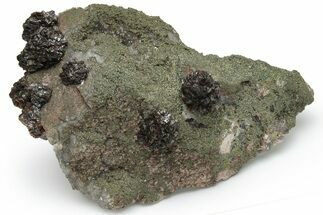This Specimen has been sold.
5.2" Amazonite Crystal Cluster with Quartz - Colorado
This is a lovely, teal blue amazonite crystal cluster mined from the 10 Percenter Claim in Park County, Colorado. Quartz crystals can be found along the edge, in small cavities and across the underside of this specimen. Another exciting feature of this crystal association is the octahedral fluorite crystals along the underside of the specimen. The largest amazonite crystal is .8" wide.
It comes with an acrylic display stand.
It comes with an acrylic display stand.
About Amazonite
Amazonite is a green variety of microcline feldspar that is the state mineral of Colorado. It has recently received a lot of attention for its prominence on the reality show “Prospectors”, which follows several groups of Colorado mineral miners. In fact, most of our amazonite is sourced from some of the prospectors on the show. High-quality crystals are found at several locations in Colorado, often in vugs associated with smoky quartz.
Its name comes from the Amazon River, where the mineral was originally thought to be found, though is now doubtful to occur in the region. Its distinct blue-green color was originally thought to be caused by copper content, but it is actually due to very small quantities of lead present in the mineral. The lead is locked away in the crystal structure so it poses no health risk from handling.
Amazonite is a green variety of microcline feldspar that is the state mineral of Colorado. It has recently received a lot of attention for its prominence on the reality show “Prospectors”, which follows several groups of Colorado mineral miners. In fact, most of our amazonite is sourced from some of the prospectors on the show. High-quality crystals are found at several locations in Colorado, often in vugs associated with smoky quartz.
Its name comes from the Amazon River, where the mineral was originally thought to be found, though is now doubtful to occur in the region. Its distinct blue-green color was originally thought to be caused by copper content, but it is actually due to very small quantities of lead present in the mineral. The lead is locked away in the crystal structure so it poses no health risk from handling.
About Quartz
Quartz is the name given to silicon dioxide (SiO2) and is the second most abundant mineral in the Earth's crust. Quartz crystals generally grow in silica-rich environments--usually igneous rocks or hydrothermal environments like geothermal waters--at temperatures between 100°C and 450°C, and usually under very high pressure. In either case, crystals will precipitate as temperatures cool, just as ice gradually forms when water freezes. Quartz veins are formed when open fissures are filled with hot water during the closing stages of mountain formation: these veins can be hundreds of millions of years old.
Quartz is the name given to silicon dioxide (SiO2) and is the second most abundant mineral in the Earth's crust. Quartz crystals generally grow in silica-rich environments--usually igneous rocks or hydrothermal environments like geothermal waters--at temperatures between 100°C and 450°C, and usually under very high pressure. In either case, crystals will precipitate as temperatures cool, just as ice gradually forms when water freezes. Quartz veins are formed when open fissures are filled with hot water during the closing stages of mountain formation: these veins can be hundreds of millions of years old.
About Fluorite
Fluorite is a halide mineral comprised of calcium and fluorine, CaF2. The word fluorite is from the Latin fluo-, which means "to flow". In 1852 fluorite gave its name to the phenomenon known as fluorescence, or the property of fluorite to glow a different color depending upon the bandwidth of the ultraviolet light it is exposed to. Fluorite occurs commonly in cubic, octahedral, and dodecahedral crystals in many different colors. These colors range from colorless and completely transparent to yellow, green, blue, purple, pink, or black. Purples and greens tend to be the most common colors seen, and colorless, pink, and black are the rarest.
Fluorite is a halide mineral comprised of calcium and fluorine, CaF2. The word fluorite is from the Latin fluo-, which means "to flow". In 1852 fluorite gave its name to the phenomenon known as fluorescence, or the property of fluorite to glow a different color depending upon the bandwidth of the ultraviolet light it is exposed to. Fluorite occurs commonly in cubic, octahedral, and dodecahedral crystals in many different colors. These colors range from colorless and completely transparent to yellow, green, blue, purple, pink, or black. Purples and greens tend to be the most common colors seen, and colorless, pink, and black are the rarest.
SPECIES
Microcline var. Amazonite, Quartz & Fluorite
LOCATION
10 Percenter Claim, Lake George, Park County, Colorado
SIZE
5.2 x 3.4". Largest crystal .8" wide
CATEGORY
ITEM
#129242
 Reviews
Reviews
